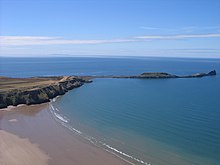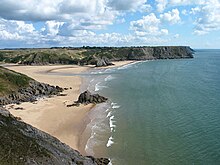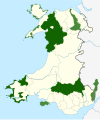Gower Peninsula
Gower Peninsula
| |
|---|---|
 Rhossili beach | |
Location within Swansea | |
| Population | 76,400 |
| OS grid reference | SS465904 |
| Principal area | |
| Preserved county | |
| Country | Wales |
| Sovereign state | United Kingdom |
| Postcode district | Swansea |
| Police | South Wales |
| Fire | Mid and West Wales |
| Ambulance | Welsh |
| UK Parliament | |
| Senedd Cymru – Welsh Parliament | |
| Gower |
|---|
 |
Gower (Welsh: Gŵyr) or the Gower Peninsula (Penrhyn Gŵyr) is in South West Wales and is the most westerly part of the historic county of Glamorgan, Wales. It projects towards the Bristol Channel. In 1956, the majority of Gower became the first area in the United Kingdom to be designated an Area of Outstanding Natural Beauty.
Until 1974, Gower was administered as a
Since its establishment in 1999, the Gower Senedd constituency has only elected Labour members. The Gower constituency in Westminster had previously also elected only Labour Members of Parliament (MPs) since 1908; the longest run (with Normanton and Makerfield) of any UK constituency. This ended in 2015 when the Conservatives took the seat. In 2017, it returned to Labour. The area of both constituencies covers the peninsula and the outer Gower areas of Clydach, Gowerton, Gorseinon, Felindre, Garnswllt and encompasses the area of the historic Lordship of Gower apart from the city of Swansea.
Geography

causeway exposed at low tide
About 70 square miles (180 km2) in area, Gower is known for its
The southern coast consists of a series of small, rocky or sandy bays, such as Langland and Three Cliffs, and larger beaches such as Port Eynon, Rhossili and Oxwich Bay. The north of the peninsula has fewer beaches, and is home to the cockle-beds of Penclawdd.
The northern coast is mainly salt marsh, and is used for raising Gower salt marsh lamb which was registered as a Protected Designation of Origin in 2021 under UK law[5][6] and in 2023 under EU law.[7]
The interior is mainly farmland and
History
Stone Age
Wales is known to have been inhabited since at least the
Bronze Age

Gower is also home to menhirs or standing stones from the Bronze Age. Of the nine stones[when?], eight remain today. One of the most notable of the stones is Arthur's stone near Cefn Bryn. Its 25-ton capstone was most likely a glacial erratic (a piece of rock/conglomerate carried by glacial ice some distance from the rock outcrop from which it came): the builders dug under it and supported it with upright stones to create a burial chamber. The remains of Sweyne Howes on Rhossili Down, Penmaen Burrows Tomb (Pen-y-Crug) and Nicholaston Long Cairn are three other well-known Neolithic chambered tombs. During the Bronze Age, people continued to use local caves for shelter and for burying their dead. Bronze Age evidence, such as funeral urns, pottery and human remains, has been found in Tooth Cave at Llethryd, Culver Hole (Port Eynon) and Cathole Cave. With the transition into the Iron Age, hill forts (timber fortifications on hill tops and coastal promontories) and earthworks began to appear. The largest example of this type of Iron Age settlement in the Gower Peninsula is Cilifor Top near Llanrhidian.
Roman era

Roman occupation brought new settlement. The Romans built Leucarum, a rectangular or trapezoidal fort at the mouth of the River Loughor, in the late 1st century AD to house a regiment of Roman auxiliary troops. Its remains are located beneath the town of Loughor. Stone defences were added to the earthen ditch and rampart by AD 110 and the fort was occupied until the middle or end of that century. However, it was later abandoned for a time and in the early 3rd century the ditch naturally silted up. It appears to have been brought back into use during the reign of Carausius who was worried about Irish raids, but was abandoned again before the 4th century. A Norman castle was later built on the site.
Anglicisation
Following the
As an Anglo-Norman peninsula isolated from its Welsh hinterland but with coastal links to other parts of south Wales and southwest England, it developed its own Gower dialect of English.
Glamorgan

In 1535, the
Present day
Agriculture remains important to the area with tourism playing an ever-increasing role in the local economy. The peninsula has a Championship status golf course at Fairwood Park just off Fairwood Common, which twice hosted the Welsh PGA Championships in the 1990s. Meanwhile, the Gower Golf Club at Three Crosses hosts the West Wales Open, a two-day tournament on Wales' professional golf tour, the Dragon Tour. Gower is part of the Swansea travel to work area.[11]
Landmarks
There are six castles on the Gower Peninsula: Landimore Castle—also known as Bovehill Castle—Oystermouth Castle, Oxwich Castle, Pennard Castle, Penrice Castle, Weobley Castle and numerous cairns and standing stones.
Four beaches have
Other beaches:
Llethryd Tooth Cave
The Llethryd Tooth Cave, or Tooth Hole cave, is a
At 1,525 m long (nearly 1 mile), the Tooth Cave is the longest cave in Gower. It has tight and flooded sections, and so is kept locked for safety.[20][21]
Representation in the media
- Mumbles set the scene for a six-part drama Ennals Point featuring Welsh actor Philip Madoc. The series focused on the local lifeboat crew (1982)
- The Susan Howatch novel The Wheel of Fortune is primarily set in and near the Gower Peninsula, which plays an important part in the plot of the novel (1984)
- The film, Gower Boy, by artist Gee Vaucher and musician Huw Warren—a gentle, contemplative exploration of the Gower Peninsula in Wales—debuted at the 14th Raindance Film Festival (2006)[22]
- Rhossili and Worm's Head feature in the Doctor Who episode New Earth (2006)[23]
- Rhossili Bay beach has been a location for the Lloyds Banking Group adverts featuring the iconic black horse galloping along the miles of sandy beach.[24][25][26]
- A fictional village in 1918, near The Worm's Head, is the location of a Charles Todd atmospheric mystery novel, "A Forgotten Place" (2018)
See also
- Gower (electoral ward)
- Gower (UK Parliament constituency)
- Gower dialect
- List of villages in Gower
- Cuisine of Gower
References
- ^ "Archives Network Wales". Archived from the original on 30 June 2009. Retrieved 27 February 2008.
- ^ "The City and County of Swansea" (PDF). Archived from the original (PDF) on 26 March 2009.
- ^ "Rhossili Bay". Enjoy Gower. Retrieved 25 January 2019.
- ^ "Pwll Du and Bishopton Local Nature Reserve". Green Map. Retrieved 8 December 2010.
- ^ "Gower salt marsh lamb receives protected status". BBC News. 11 August 2021. Retrieved 11 August 2021.
- ^ "Welsh Gower Salt Marsh Lamb first new registration under new UK Geographical Indication schemes". Department for Environment, Food & Rural Affairs. 11 August 2021.
The meat gains its unique characteristics from specific vegetation and environment of the salt marshes on the north Gower coastline, where the lambs graze over long distances for more than half of their lifetime.
- ^ "Commission Implementing Regulation (EU) 2023/1547 of 26 July 2023 entering a name in the register of protected designations of origin and protected geographical indications ('Gower Salt Marsh Lamb' (PDO))". European Commission. 27 July 2023. Retrieved 29 July 2023.
- ^ Gower (2008). In Encyclopædia Britannica. Retrieved July 22, 2008, from Encyclopædia Britannica Online
- ^ "Carving found in Gower cave could be oldest rock art". BBC News. 25 July 2011. Retrieved 28 July 2011.
- Clarke, G.T., Cartae, vol.3, pp.234–5
- ^ "National Statistics Online" (PDF).
- ^ "Keep Wales Tidy – Tourism – Blue Flags". Archived from the original on 2 November 2006.
- ^ "Keep Wales Tidy – Tourism – Seaside Award Beaches 2006". Archived from the original on 14 September 2007.
- ^ "Keep Wales Tidy – Tourism – Green Coast Award Beaches 2005". Archived from the original on 6 October 2007.
- ^ "Key Sites Southeast Wales – Neolithic and earlier Bronze Age" (PDF). Research Framework for the Archaeology of Wales website. Research Framework for the Archaeology of Wales. 22 December 2003. Retrieved 4 November 2008.
- ^ "Tooth Cave (305613)". Coflein. RCAHMW. 11 July 2002. Retrieved 4 November 2008.
- ^ "Bibliography of Cave Sites Literature". Chamberlain, A.T. & Williams, J.P. 2000 A Gazetteer of Welsh Caves, Fissures and Rock Shelters Containing Human Remains. Department of Archaeology and Prehistory, University of Sheffield. 5 December 2000. Archived from the original on 9 June 2010. Retrieved 4 November 2008.
- ^ "Bibliography of Cave Sites Literature". Chamberlain, A.T. & Williams, J.P. 2000 A Gazetteer of Welsh Caves, Fissures and Rock Shelters Containing Human Remains. Department of Archaeology and Prehistory, University of Sheffield. 5 December 2000. Archived from the original on 4 May 2006. Retrieved 4 November 2008.
- ISSN 0079-497X.
- ^ "Tooth Cave". UK Caves database website. UK Caves database. 2008. Retrieved 4 November 2008.
- ^ "Gower Caves". Explore Gower. Stella Elphick. 2008. Archived from the original on 26 January 2019. Retrieved 25 January 2019.
- ^ "Fourteenth Raindance Film Festival | 27.09.06 – 08.10.06". 14 November 2006. Archived from the original on 14 November 2006.
- ^ "The Welsh Connection: 5 Factoids about the Doctor and Wales". BBC. 1 March 2015. Retrieved 1 March 2015.
- ^ "Twitter: Lloyds Bank". May 2021. Retrieved 13 August 2021.
- ^ "Lloyds Bank Press Release" (PDF). 8 April 2017. Retrieved 13 August 2021.
- ^ Turner, Paul (7 April 2017). "Rhossili Bay hits the small screen in new campaign". WalesOnline.
Library
- Prehistoric Gower, The Early Archaeology of West Glamorgan, by J. G. Rutter, 1949 (published by Welsh Guides, York Street, Swansea)
- Gower, by Olive Phillips, 1956 (published by Robert Hale Limited, London)
- Gower Journey, by A. G. Thompson, c1960 (self published by the author, Principality Chambers, Swansea)
- Portrait of Gower, by ISBN 0709155778)
- The Gower Coast: A Coastline Walk And Guide To The History, Legends, Shipwrecks & Rescues, Smuggling, Castles & Caves, Including The Story Of The Dollar Ship, by George Edmunds, 1979 (ISBN 0906570018)
- The Gower Peninsula, by Lawrence Rich (for The National Trust) (ISBN 9781843592754)
- The Story of Gower, by Wendy Hughes, 1996 (ISBN 0863812171)
- Historic Gower, by Paul Davies, 1997 (ISBN 0715407325)
- Gower: A Guide to Ancient and Historical Monuments on the Gower Peninsula, by Diane M. Williams for ISBN 1 85760 073 8)
- Images of Wales: Gower Peninsula, by David Gwynn, 2002 (ISBN 075242615X)
- The People of Gower, by Derek Draisey, 2003 (ISBN 0954654404)
- Gower Rogues, by Derek Draisey, 2006 (ISBN 0954654439)
- Gower, by Jonathan Mullard (in The New Naturalist Library, ISBN 0007160666)
- Gower in History: Myth, People, Landscape, by ISBN 9780956233202)
- Gower, by ISBN 9781848510524)
- Real Gower, by Nigel Jenkins, 2014 (ISBN 9781781722190)
- Black Apples of Gower, by ISBN 978-1-908213-45-7)
External links
- Gower Hidden History blog
- Gower Wildlife blog
- Visual Guide to Gower
- Gower Peninsula at Curlie
- BBC Gower website Archived 3 September 2012 at the Wayback Machine
- The official website of The Gower Society



